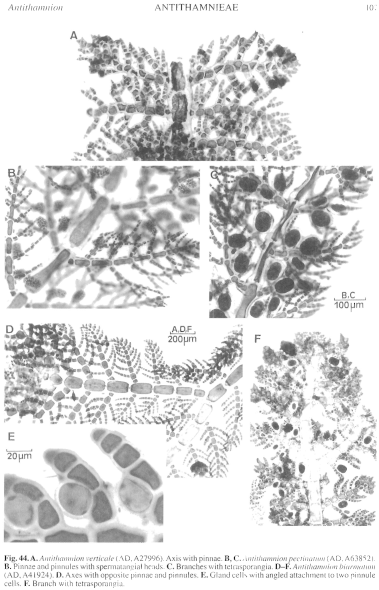|
|
|
|
|
|||||||||||
|
Electronic Flora of South Australia Species Fact Sheet
Phylum Rhodophyta – Order Ceramiales – Family Ceramiaceae – Tribe Antithamnieae
Selected citations: De Toni 1903: 1397. Huisman & Walker 1990: 419. Lucas 1909: 51. Lucas & Perrin 1947: 352. Silva et al. 1996: 380. Wollaston 1968: 299.
Synonyms
Callithamnion verticale Harvey 1855a: 561. J. Agardh 1876: 26. Sonder 1881: 10. Tisdall 1898: 502? Wilson 1892: 187.
Callithamnion horizontale Harvey 1855a: 560. J. Agardh 1876: 26; 1892: 20. Sonder 1881: 10. Tisdall 1898: 502.
Antithamnion horizontale (Harvey) J. Agardh 1892: 20; 1896, index p. 1 . De Toni 1903: 1398. Lucas 1909: 51; 1929b: 52. Lucas & Perrin 1947: 352. Reinbold 1898: 53.
Callithamnion dimorphum Harvey 1863, synop.: liv.
Thallus (Fig. 44A) light to medium red, with branched prostrate axes bearing erect branched fronds 1–3 cm high, axes with distichous pairs of opposite pinnate pinnae, lying in the same plane or divergent from it (probably depending on crowding). Attachment by branched rhizoidal clumps from basal pinna cells; epiphytic on various algae. Structure. Apical cells small, enlarging to 130–250 µm in diameter and L/D 1.2–1.5 in lower axes. Pinnae (Fig. 44A) closely and complanately branched, lying in the plane of thallus branching or twisted from this by crowding, with alternate, simple or once branched pinnules; rachis cells 45–75 µm in diameter and L/D 0.6–1.2, slightly flexuous, tapering over subterminal cells to 20–25 µm in diameter and L/D 0.5–1, terminal cells pointed; pinnule cells 35–45 µm in diameter and L/D 0.8–1.2, tapering over last few cells to pointed terminal cells; gland cells on short 3–4-celled branches on the pinnules, ovoid, covering 2–3 cells and 25–45 µm in diameter. Lateral branches probably arising from basal cells of pinnae. Cells uninucleate; rhodoplasts discoid.
Reproduction: Gametophytes unknown.
Tetrasporangia on lower pinnule cells, sessile, ovoid, 40–50 µm in diameter, decussately divided.
Type from Garden I., W. Aust. (Harvey); lectotype in Herb. Harvey, TCD (Tray. Set 267).
Selected specimens: Safety Bay, W. Aust., on Callophycus, drift (Womersley, 18.viii.1979; AD, A50788). Pearson Is, S. Aust., on Ecklonia, 48 m deep (Shepherd, 9.i.1969; AD, A33734). Elliston, S. Aust., on Dilophus robustus, drift (Womersley, 13.i.1951; AD, A13590). Vivonne Bay, Kangaroo I., S. Aust., on Lenormandia, drift (Womersley, 24.i.1946; AD, A13034). Pennington Bay, Kangaroo I., S. Aust., on Sargassum, drift (Womersley, 29.xii.1948; AD, A10478). Robe, S. Aust., on Plocamium, drift (Wollaston, 19.v.1964; AD, A27996). Warrnambool, Vic. (Watts, Sept. 1860; MEL, 10272).
Distribution: Rottnest I., W. Aust., to Warrnambool, Victoria.
Taxonomic notes: Athanasiadis (1996, p. 153) placed A. verticale and its synonyms as probable synonyms of A. hanovioides. The two species, however, are clearly distinct in that in A. verticale the pinnae are distichously arranged on the axes and the pinnules are distichous, in contrast to A. hanovioides with decussate pinnae.
References:
AGARDH, J.G. (1876). Species Genera et Ordines Algarum. Vol. 3, Part 1- Epicrisis systematic Floridearum, pp. i-vii, 1–724. (Weigel: Leipzig.)
AGARDH, J.G. (1892). Analecta Algologica. Acta Univ. lund. 28, 1–182, Plates 1–3.
AGARDH, J.G. (1896). Analecta Algologica. Cont. III. Acta Univ. lund. 32, 1–140, Plate 1.
ATHANASIADIS, A. (1996). Morphology and classification of the Ceramioideae (Rhodophyta) based on phylogenetic principles. Opera Botanica No. 128, pp. 1–216.
DE TONI, G.B. (1903). Sylloge Algarum omnium hucusque Cognitarum. Vol. 4. Florideae. Sect. 3, pp. 775–1521 + 1523–1525. (Padua.)
HARVEY, W.H. (1855a). Some account of the marine botany of the colony of Western Australia. Trans. R. Jr. Acad. 22, 525–566.
HARVEY, W.H. (1863). Phycologia Australica. Vol. 5, Plates 241–300, synop., pp. i-lxxiii. (Reeve: London.)
HUISMAN, J.M. & WALKER, D.I. (1990). A catalogue of the marine plants of Rottnest Island, Western Australia, with notes on their distribution and biogeography. Kingia 1, 349–459.
LUCAS, A.H.S. & PERRIN, F. (1947). The Seaweeds of South Australia. Part 2. The Red Seaweeds. (Govt Printer: Adelaide.)
LUCAS, A.H.S. (1909). Revised list of the Fucoideae and Florideae of Australia. Proc. Linn. Soc. N.S.W. 34, 9–60.
LUCAS, A.H.S. (1929b). A census of the marine algae of South Australia. Trans. R. Soc. S. Aust. 53, 45–53.
REINBOLD, T. (1898). Die Algen der Lacepede und Guichen Bay (Slid Australien) und deren näherer Umgebung, gesammelt von Dr. A. Engelhart-Kingston. II. Nuova Notarisia 9, 33–54.
SILVA, P.C., BASSON, P.W. & MOE, R.L. (1996). Catalogue of the Benthic Marine Algae of the Indian Ocean. (University of California Press: Berkeley, Los Angeles & London.)
SONDER, O.W. (1881). In Mueller, F., Fragmenta Phytographiae Australiae. Supplementum ad volumen undecinum: Algae Australianae hactenus cognitae, pp. 1–42, 105–107. (Melbourne.)
TISDALL, H.T. (1898). The algae of Victoria. Rep. 7th Meet. Aust. Ass. Adv. Sci., Sydney, 1898, pp. 493–516.
WOLLASTON, E.M. (1968).Morphology and taxonomy of southern Australian genera of Crouanieae Schmitz (Ceramiaceae, Rhodophyta). Aust. J. Bot. 16, 217–417.
The Marine Benthic Flora of Southern Australia Part IIIC complete list of references.
Publication:
Womersley, H.B.S. (24 December, 1998)
The Marine Benthic Flora of Southern Australia
Rhodophyta. Part IIIC. Ceramiales – Ceramiaceae, Dasyaceae
©State Herbarium of South Australia, Government of South Australia
Illustration in Womersley Part IIIA, 1998: FIG. 44A.

Figure 44 enlarge
Fig. 44. A. Antithamnion verticals (AD, A27996). Axis with pinnae. B, C. Antithamnion pectinatum (AD, A63852). B. Pinnae and pinnules with spermatangial heads. C. Branches with tetrasporangia. D–F. Antithamnion biarmatum (AD, A41924). D. Axes with opposite pinnae and pinnules. E. Gland cells with angled attachment to two pinnule cells. F. Branch with tetrasporangia.

|
Email Contact: State Herbarium of South Australia |

|